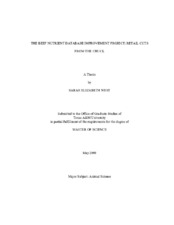| dc.description.abstract | A total of 40 beef arm chucks were collected from three cities across the United
States to study the proximate composition of their separable lean. Chucks were
fabricated 5-7 d postmortem and later cooked and dissected, or dissected raw into four
separable components, separable lean, external fat, separable seam (intermuscular) fat,
and connective tissue (considered inedible). Proximate analysis was conducted on the
separable lean component of each dissected retail cut.
Dissection data showed that multiple muscled cuts had a numerically lower
percent separable lean when compared to the retail cuts comprised of a single muscle.
Proximate analysis showed that as the mean value for moisture decreased in the retail
cut, the mean percentage of total fat increased. Least squares means of total fat
percentage were reported on the retail cuts stratified by USDA quality grade (upper
Choice, lower Choice, and Select). Some of the retail cuts had significantly different
total fat percentage of the separable lean when considering the differences in USDA
quality grade. Cooking yields for the three methods utilized were numerically different.
The cuts that were roasted had the highest cooking yield (80.72 %), followed by cuts that were grilled (76.58%), and finally cuts that were braised (66.13%). Differences in final
endpoint temperature for each cut may account for the differences between cooking
methods.
This study was designed to acquire data to update the National Nutrient Database
for Standard Reference, as well as to provide nutritional information for cuts that are not
presently in the database. This study evaluated thirteen cooked cuts and twelve raw cuts
in an effort to increase the number of retail cuts available to search for nutrient
information in the National Database. | en |


